Posted by
Susan Sharma
on
August 20, 2009

 The talk given by Mr.Kapil Sibal, Union Minister for HRD on 29th July 2009 at Teen Murti house, was really `Manna’ to an environmentalist’s ear. The crux of his talk was that `Environment Education’ should be at the center of education, all other knowledge
can follow. All scientific data and processes are available with nature. "Bring science into education; all aspects of science can be learnt from nature. Science taught in correlation with nature is understood best. "Education for sustainable development in
an era of climate change, calls for a change in mindsets. The need is to reach out to communities and have a dialogue. Teachers within the community will have knowledge at ground level". " Teaching of a subject must be holistic. Environmental issues can be
effectively linked to say, automobile engineering. Teaching of music can take off from nature…." " Communicating with nature creates a sense of preservation of nature at the heart of education…" "The government’s aim is to connect all villages of India in
the next three years. This can lead to leapfrog in education. We must be ready with relevant content in the meantime." Heart of all content is nature.
The talk given by Mr.Kapil Sibal, Union Minister for HRD on 29th July 2009 at Teen Murti house, was really `Manna’ to an environmentalist’s ear. The crux of his talk was that `Environment Education’ should be at the center of education, all other knowledge
can follow. All scientific data and processes are available with nature. "Bring science into education; all aspects of science can be learnt from nature. Science taught in correlation with nature is understood best. "Education for sustainable development in
an era of climate change, calls for a change in mindsets. The need is to reach out to communities and have a dialogue. Teachers within the community will have knowledge at ground level". " Teaching of a subject must be holistic. Environmental issues can be
effectively linked to say, automobile engineering. Teaching of music can take off from nature…." " Communicating with nature creates a sense of preservation of nature at the heart of education…" "The government’s aim is to connect all villages of India in
the next three years. This can lead to leapfrog in education. We must be ready with relevant content in the meantime." Heart of all content is nature.
|
Posted by
Susan Sharma
on
May 06, 2008

We also managed an elephant ride into the 20 sq. km rhino enclosure . The rhinos seemed placid , chewing on elephant grass, which came to life with jumping hog deer as we maneuvered our wa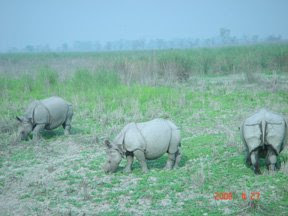 y. y.
The jeep ride into the forest in the evening proved exciting- Herds of swamp deer could be seen from the machan. The deer had shed their antlers, which were sprouting again for the next mating season display. The pugmarks of an adult tigress
and four cubs seemed very recent and we followed them. Sure enough the huge tigress surprised a herd of sitting swamp deer into sudden action. Calls by langur and deer filled the forest air. The whistle of a train came from the distance and a speeding train
could be seen in the horizon view from the machan. The Gonda-Bareilly railway line passes through the National Park. Animals in this reserve must be quite used to this noise by now. One tiger and two elephants died in the tracks recently, Sonu, our guide informed.
Ten trains run through the reserve in one day and every now and then we encountered people collecting fodder and dried wood in the forest. The train station located right inside the reserve carried people in and out regularly making a mockery of National Park
rules.
Tigers and people are living on the edge in this Tiger Reserve, which obviously had a very good prey base. Herds of hog deer and a few barking deer and chital greeted us on the jeep route. Wild hog, another favorite of the tiger also showed themselves often.
Swamp deer herds, which kept near water bodies, avoided tourist routes, but were obviously thriving as well.
Read the full report at
http://www.indianwildlifeclub.com/usercontent/userArticle.asp?id=27
|
Posted by
Susan Sharma
on
May 05, 2008

Dudhwa National Park-26-28 April, 2008
 Anthill in
Dudhwa Anthill in
Dudhwa
Situated on the Indo-Nepal border, in Uttar Pradesh, the Dudhwa Tiger Reserve with an area of 614 sq. Km is one of the few remaining examples of the diverse Terai region. The northern edge of the reserve lies along the Indo-Nepal border and the river Suheli
marks the southern boundary. It is home to a large number of rare and endangered species which includes Tiger, Leopard, Swamp deer, Hispid hare, Bengal Florican, etc.
The grasslands of the reserve are the habitat of the largest kind of Indian deer-the Swamp deer or the Barasingha, so called because of their magnificent antlers (bara-twelve;singha-antler). Decline in their habitats led to a drastic decline in numbers and
a small area named Sonaripur Sanctuary was set aside in 1958 for the conservation of this rare species of deer. Later, it was upgraded to cover an area of 212 sq. km and was renamed the Dudhwa Sanctuary. In 1977, the area was further extended to include over
614 sq. km and was declared a National Park. Eleven years later, in 1988, when Dudhwa became a part of Project Tiger, the area of the Kishanpur Sanctuary was added to create the Dudhwa Tiger Reserve.
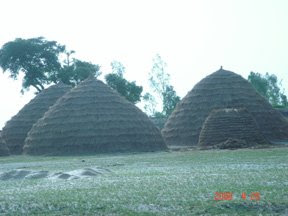
It was the time of wheat harvesting and one could see neatly stacked wheat stalks at several places enroute to Dudhwa via Bareilly from Delhi. We had been told the journey to Dudhwa would be about nine hours. and also that we can expect narrow
roads for about 50 km or so. But the roads we encountered came out to be really bad both on the way up via Shahjehanpur and the way down, when we came via Pilibhit. Fourteen hours by car to a Tiger Reserve one had heard little about!
Once we entered the reserve the roads were well maintained and the first surprise was a meter gauge railway right into the forest, in fact right into the core area as we observed later. Villagers we met at a tea stall were excited that the track had been approved
for conversion into broad gauge.
We had booked our stay in Forest Rest Houses inside the reserve. The place was well lit with CFL bulbs running entirely on solar cells. Even the adjoining staff quarters had solar power.
Early next day we were told that two of the elephants allotted for safari had been requisitioned by Forest Dept for “operation man-eater leopard”. The leopards in Dudhwa lift cattle and turn man- eaters often. Compared to 77 tigers in the Reserve, the leopard
numbers were only ten.
We are allowed to explore the forest in our own vehicle and that is what we did. Smoldering ash from a recent forest fire greeted us first. Soon we glimpsed chital and swamp deer and tiger pugmarks.
We also managed an elephant ride into the 20 sq. km rhino enclosure . The rhinos seemed placid , chewing on elephant grass, which came to life with jumping hog deer as we maneuvered our wa y. y.
The jeep ride into the forest in the evening proved exciting- Herds of swamp deer could be seen from the machan. The deer had shed their antlers, which were sprouting again for the next mating season display. The pugmarks of an adult tigress
and four cubs seemed very recent and we followed them. Sure enough the huge tigress surprised a herd of sitting swamp deer into sudden action. Calls by langur and deer filled the forest air. The whistle of a train came from the distance and a speeding train
could be seen in the horizon view from the machan. The Gonda-Bareilly railway line passes through the National Park. Animals in this reserve must be quite used to this noise by now. One tiger and two elephants died in the tracks recently, Sonu, our guide informed.
Ten trains run through the reserve in one day and every now and then we encountered people collecting fodder and dried wood in the forest. The train station located right inside the reserve carried people in and out regularly making a mockery of National Park
rules.
Tigers and people are living on the edge in this Tiger Reserve, which obviously had a very good prey base. Herds of hog deer and a few barking deer and chital greeted us on the jeep route. Wild hog, another favorite of the tiger also showed themselves often.
Swamp deer herds, which kept near water bodies, avoided tourist routes, but were obviously thriving as well.
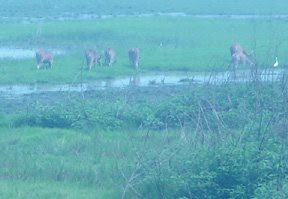
Swamp deer in Dudhwa
The guide pointed out to a distant herd of wild elephants, they are our guests, he said. “They have come from Kosi Tappu wildlife reserve of Nepal”.
A large partridge scampered away. Could it be the swamp partridge? Our guide for the day was not very sure. A serpent eagle displayed itself on a large tree. The cry of the brown headed fishing eagle made us reach for the binoculars. Bird life in the forest
is good though not as plentiful as in Corbett Reserve.
I almost forgot to mention the wildlife spotted near our dwelling. As I was opening the locked room of the forest hut, a sound of something falling behind me made me look back. A pit vper had just decided to drop down from the roof of the verandah. As I moved
away, it started hurtling towards me. Soon, the hot floor made it difficult for it to move. The canteen boys came, swirled it around a stick a few times and then dropped it across the wall of the adjoining forest. What if someone gets bitten, ( vipers seldom
bite though) I asked. The local Hakim has herbal medicines for the bite and they work, he said. According to him, no one he knew died of the bite.
I remembered having read in an article in the BNHS magazine that the violet spikes of Pogostemon bengalensis, seen in the forests around, is the only confirmed herbal antidote for the venom of the viper. Thank God I did not have to try it!
The Reserve is dotted all around with anthills- a sure sign that sloth bear are likely to be around. Though we came across footprints and scat often, the bear himself proved elusive.
The Park did not have too many visitors as many of the forest guest houses were under renovation. A tree house with a good view of “Tiger Tal” is complete and is sure to be a hit with tourists. On the whole, a Park with huge tourist potential, if managed right.
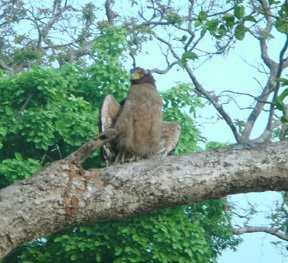
Serpent eagle
|
Posted by
Susan Sharma
on
May 02, 2008
"Such is the lack of information about the biodiversity of Arunachal Pradesh that the
Arunachal Macaque (Macaca munzala) - a species of monkey already known to the native people of Arunachal (especially to the Monpas of Tawang and the tribes of the West Kameng District) as Munzala or the “monkey of the
deep forest”, remained unknown to scientists and biologists till it was “discovered” in 2004. The so called “discovery” was waiting to happen and it was after more than a hundred years that a new species of macaque was discovered (the last recent discovery
being the Indonesian Pagai Island Macaque in 1903)."
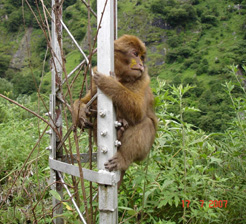
Arunachal Macaque in Tawang (Photo:Govind Singh)
Source:
http://www.indianwildlifeclub.com/ezine/index.asp?m=5&y=2008
|
Posted by
Susan Sharma
on
April 17, 2008
21 April
2008, at 7.30 PM
IndianWildlifeClub.com invites you to
“A Tale of Two National Parks”
Screening of two films
at the Epicentre, Gurgaon, on 21 April, 2008
Details:
Venue: Epicentre,
Apparel House, Sector 44, Gurgaon
Date: 21 April, 2008 (Monday)
Timing: 7.30 PM to 9.00 PM
Entrance is free
Films: “ Living with the Park”-Ranthambore National Park
“To Corbett with Love”-Corbett National Park
Both the films are directed by Dr.Susan Sharma who will introduce
the films and interact with the audience.
|
Posted by
Susan Sharma
on
April 10, 2008

Ladybugs, 720,000 of them, have been released in New York City to help protect one of the city’s biggest apartment complexes from pests.
The bugs will crawl into plants, flowers and shrubs in the Stuyvesant Town and Peter Cooper Village complex in search of insects whose smell attracts them. Buying the bugs-at $16.50 for 2,000-means the complex’s owner can avoid using chemical insecticides.
"In most cases,we reach out to a can of pesticide-and we kill not only the ’bad guys’ but the ’good guys’, said Eric Vinje, owner of Planet Natural, which supplied the pestkillers.
He said a ladybug can eat up to 50 pests a day, plus insect eggs.
Source: The Hindu, Ocober 22, 2007
Photo: Ladybug on a carrot flower. The flowers are white with a pink centre to attract bees and insects. (Susan Sharma)
|
Posted by
Susan Sharma
on
April 04, 2008

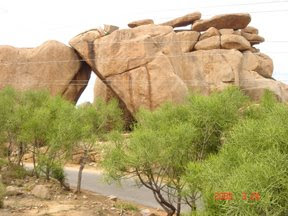
As we entered Hampi, the ancient city of Vijayanagar, scattered with the ruins of bygone splendour in granite stone, WILDLIFE was far from my thoughts. Still, a simple board announcing "Daroji Bear sanctuary just 15 km from here" caught my eye. We asked our
guide if it was worth the trip. "sure," he said," be there between four and five in the evening and you are sure to see the sloth bears”. I looked at the watch. It was 11 am. After walking through the Vitthala and Virupaksha temples during the day we can hope
to make it to the sanctuary before dark since we had hired a vehicle for the day.
I had heard about Wildlife SOS rescuing dancing bears and releasing them in rescue centres. May be this was one of them, I thought to myself. We reached the sanctuary in the evening, after driving through barren stone covered landscape for the most part. We
drove through the sanctuary gate into an expanse of more granite blobs and keekar trees. Well placed sign boards throughout the sanctuary (the sign boards were there on the road along the drive to Daroji too) made sure we reached the watch tower by 5.30 pm
or so.
To our surprise, there were a few tourists including a forest guard already there waiting for the bears to come out of their stone caves and descend to the tree and stone top where platefuls of jaggery had been placed by the guards to lure them. The bears are
wild and are the residents of this area since time immemorial. Besides sloth bears, leopards, wild boar ( the symbol of both Chalukia and Vijayanagara dynasty) and peacocks are easily seen, the forest guard said. The peafowl were already tasting the food on
the trees. Wild boars cannot climb the trees but a couple of them patiently waited for the bears, hoping for crumbs falling to the ground, no doubt.
Everyone was quiet and the only sounds were those of the partridges, which could be seen scampering about. ‘There he is’, muffled cries went out. A huge black figure had come out and was on his hind legs searching for something on a high rock cleft. ‘There
is some food there too’-the guard informed. Soon three more bears emerged from under the rocks-huge hefty and black -very unlike the craggy bears one remembered from childhood-the bears, which danced for the kalandahar.
One huge bear climbed the tree and started eating. Peafowl and boars in attendance on the ground. One could watch the magnificent creatures through some powerful binoculars. They were too far away for my still camera to capture them.
I remembered seeing sloth bears in Ranthambore a few years back. I had also seen them in Corbett National Park during a visit nearly 25 years ago. ( See a snap of the bear which came to Dhikala below). From those days the sloth bears have reduced steadily in
numbers due to poaching and habitat destruction that the forest department found it necessary to protect the species in an exclusive sanctuary. The sanctuary was formed in the year 1994.
The rock-strewn hillocks that stretch between Daroji of Sandur taluk and Ramasagar of Hospet Taluk in Bellary district have been the abode of Indian Sloth Bear (Melursus ursimus) since ages. In October 1994, the Government of Karnataka declared 5,587.30 hectares
of Bilikallu reserve forest as Daroji Bear Sanctuary.
It is estimated that about 120 Sloth Bears are living in this sanctuary, apart from Leopards, Hyena, Jackals, Wild Boars, Porcupine, Pangolins, Star Tortoise, Monitor Lizard, Mongoose, Pea Fowls, Partridges, Painted Spur Hen, Quails etc. About 90 species of
birds, and 27 species of butterflies have also been identified in this sanctuary in a preliminary survey.
Here is a link to the youtube video showing sloth bear from Ranthambore
http://www.youtube.com/watch?v=fQ9QxZ7hS5U

The bear which came to Dhikala 25 years ago!
|
Posted by
Susan Sharma
on
March 12, 2008
A Park exclusively for butterflies, exists in Thenmala hills, Kollam, Kerala. Situated on 3.5 hectares of forests, the artificially created safari park is filled with roosting plants, nectar providing flowers and a host of leafy shrubs that provide food
for caterpillars. Butterflies here are not kept in captivity. The humid climate, artificial waterfalls and puddles, host plants and shrubs attract butterflies. Monsoon season is said to attract maximum variety.
Rare and endemic beauties like ’Paris Peacock’ and ’Southern Bird Wing’ can be spotted here.

|
Posted by
Susan Sharma
on
March 12, 2008
Rose-ring and Alexander parakeets are listed under schedule IV of Wildlife Protection Act. ( No person shall hunt any wild animal specified in Schedule, I, II, III and IV except when specifically authorised by Chief Wildlife Warden under exceptional circumstances).
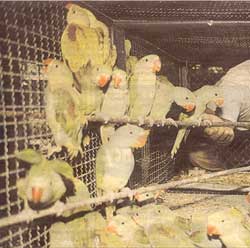
Seelampur in North East Delhi seems to be the "adda" for poaching these birds as several raids reveal. Houses of poachers here have permanent cages built into the walls. These cages are so tiny that birds develop wounds through constantly pecking at one
another.
After a recent raid of 150 parakeets, PFA(People for Animals) offiials said forty of the resued birds collapsed en-route to the Jain Bird Hospital. 35 healthy ones went to the police station.
The fate of poached birds are sad, to say the least. Hear what a zookeeper has to say about these unfortunate ones!
http://www.indianwildlifeclub.com/ezine/detail.asp?m=3&y=2004&at_id=233
|
Posted by
Susan Sharma
on
March 04, 2008

“Authorities in China recently
launched a crackdown on Web sites that openly trade in animal products made from threatened species, experts say.
The move follows pressure from two international wildlife advocacy groups, which found thousands of items made from protected species for sale on major Chinese Internet auction sites in 2007………
………………….
IFAW’s Gabriel noted that the two most popular wildlife products traded online in China
are elephant ivory and items made from tiger bone.
Ivory products include decorative and religious-themed carved figurines, chopsticks, and jewelry. They are sold among collectors, who are mostly white-collar and well educated, Gabriel said.
Tiger bone, which has been banned in China for the past 15 years, has been used in traditional Chinese medicine to treat rheumatism.
Some manufacturers still produce tiger-bone wine and claim that it has magical powers and benefits for the skin.
The market for tiger-bone products generally consists of lower-income people in rural areas who shop at local vendors, though a small market for tiger-bone products exists online, Gabriel noted.
Rhino horn, tortoise shell, and antelope horn are also banned from being traded online.
One of the key challenges to policing online trade in illegal products, the conservationists note, is Chinese vendors’ ability to tweak the language to manipulate descriptions of their products.
"In other languages it might be difficult, but Chinese is tonal, and if you change the tone it could be a different word," Gabriel said.”
Source:
National Geographic News 29 Feb 08
|